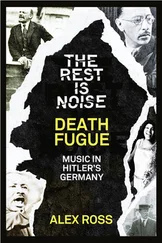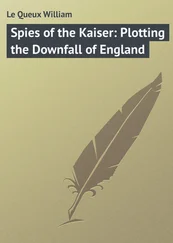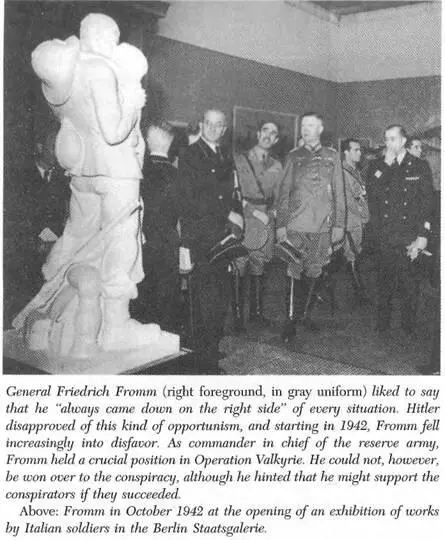
Fromm certainly did not number among “Hitler’s generals,” and to his friends he frequently expressed his distaste for the Nazis. He was also clever enough to deduce what Olbricht and Stauffenberg were up to from all the secretive activity in their offices and the visitors whom they received, he always acted, however, as if it was none of his business. He slipped up only once, in mid-July 1944, when, in a particularly buoyant mood, he told Olbricht to be sure, in the event of a putsch, not to forget Wilhelm Keitel, whom Fromm hated. 28Although Fromm did nothing to hinder the uprising, no one who knew him had any doubt that he would not assist it either and, most important, that he would definitely not sign the Valkyrie orders. The question of how he should be handled therefore remained open. By the end of October all other preparations were ready. Tresckow gave Witzleben the orders declaring martial law, and Witzleben, who was to assume command of the Wehrmacht once a coup was under way, affixed his signature.
Scarcely had these preparations been completed, however, when Tresckow was ordered back to the front. Thus it was Stauffenberg who look on responsibility for igniting the “initial spark.” It was hoped that Tresckow would again assume a pivotal position in the military command from which he could provide support from the front as soon as the home army initiated the uprising, but this was not to be. The army personnel office had recommended him, along with other candidates, to serve as chief of staff for Army Group South under Field Marshal Erich von Manstein, but Manstein rejected him. Instead, Tresckow assumed command of an infantry regiment in a division led by Manstein. Rumor had it that he was being put in “cold storage.” 29
The problem now as ever was to find an officer who had access to Hitler and was determined to kill him. Stieff had recently declared himself ready, but when Stauffenberg sought him out he stalled. He did, however, take possession of the explosives Stauffenberg brought him and finally demanded the assistance of an accomplice, apparently in order to help steel himself. Stauffenberg turned to Colonel Joachim Meichssner, the head of the organizational section of the OKW operations staff, who had tentatively promised in September to be the assassin. At the same time, Stieff was apparently considering making an attempt with two young officers on his staff, Major Joachim Kuhn and First Lieutenant Albrecht von Hagen; but after further consideration, he again backed out, explaining that it was impossible to carry explosives into a briefing without being noticed. In truth, it was probably fear that deterred this lively and somewhat unstable man from action.
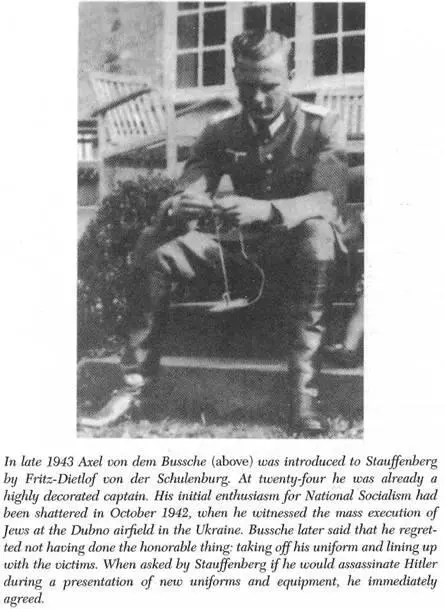
These harrowing efforts to find someone who would set off the “initial spark” prompted Stauffenberg to make contact, through Fritz-Dietlof von der Schulenburg, with one of the “reliable young officers” he had heard about in the spring. Axel von dem Bussche was a highly decorated twenty-four-year-old captain. His initial naive enthusiasm for Hitler and National Socialism had already dimmed considerably when, in early October 1942, he happened to witness the mass execution of several thousand Jews at the Dubno airfield in the Ukraine, a shock he never recovered from. There were, he said, only three possible ways for an honorable officer to react: “to die in battle, to desert, or to rebel.” When Stauffenberg now asked him if he would be willing to kill Hitler, Bussche accepted without hesitation.
The plan was to use a previously scheduled presentation of new uniforms and equipment to lure Hitler from his bunker at headquarters, where he increasingly ensconced himself. Bussche was to explain the features and advantages of the new items and then, at a suitable moment, to set the fuse on the bomb, leap on Hitler, and hold him tight for the three or four seconds until the explosion. Toward the end of November the presentation seemed likely to take place at any moment. Bussche traveled to Führer headquarters in East Prussia and waited. “The sunny late-autumn days amid the forests and lakes are imbued with the heightened intensity a soldier feels before an attack,” he wrote. 30But the presentation was postponed again and again. Finally Stieff informed the other conspirators that the model uniforms had been in a railroad car that was destroyed in one of the bombing raids on Berlin. Replacements would probably not be ready before January. Bussche returned to the front, where he was severely wounded early in the new year, losing a leg, which disqualified him from further attempts.
An unexpected complication now arose. Bussche was left with a bomb in his suitcase and no way of disposing of it. He found himself transferred from one hospital to another, all the while carrying his secret along with him. Not until the fall of 1944 did he finally find a sympathetic officer who threw it into a lake for him. 31Stieff, too, had been left with explosives on his hands when he backed out of killing Hitler. He assigned the disposal of “the stuff” to Kuhn and Hagen, who came up with the ill-advised idea of burying the explosives and detonators in the woods under a watchtower within the boundaries of Führer headquarters. As it happened, a military police patrol spotted them, but they managed to escape without being recognized. Had the incident been brought to light it might well have had serious consequences for the entire resistance. Fortunately, however, the investigation was assigned to a close confidant of Hans Oster’s named Lieutenant Colonel Werner Schrader, and thus a conspirator ended up investigating the conspiracy. 32
In January, after Bussche had been wounded, Stauffenberg approached Lieutenant Ewald Heinrich von Kleist. Once again, the plan was to assassinate Hitler during the presentation of new uniforms. Stauffenberg did not press Kleist, saying only that the earlier attempt had failed. Kleist said he wanted first to speak with his father, the same Ewald von Kleist-Schmenzin who in the summer of 1938 had traveled to London at the behest of Oster and Beck to meet with Vansittart and Churchill. When the son appeared at the family estate the next day and asked his father’s opinion, the elder Kleist immediately responded that this was a task he could not refuse. The son pointed out that he was being asked to do nothing less than blow himself up with Hitler. His father stood up, went to the window, and after a moment’s thought, replied, “You have to do it. Anyone who falters at such a moment will never again be one with himself in this life.” 33
But this brave resolution also failed, once again the date of the presentation was repeatedly postponed. Stauffenberg next turned to his adjutant, Werner von Haeften, who agreed in principle to carry out the task but was then dissuaded by his brother, Hans-Bernd, who raised vehement objections on religious grounds. These pangs of conscience, excuses, concerns about Hitler’s security precautions, and struggles to procure explosives and then dispose of them generated anguish and despair in the ranks of the conspirators-while meanwhile the slaughter continued on all sides. All these pressures burst forth one day when Paul Yorck von Wartenburg screamed at Gersdorff, “That swine does, after all, have a mouth that somebody could just shoot into!” 34
This very approach was adopted by Eberhard von Breitenbuch, a cavalry captain who now declared that he would do the deed. Tresckow had arranged for Breitenbuch to join Army Croup Center, where he became adjutant to the new commander in chief, Field Marshal Ernst Busch, following Kluge’s accident. On March 11 Busch was summoned to a briefing on the Obersalzberg and, as usual, look along his adjutant. Breitenbuch, not informed of the briefing until that very morning, agreed on the spot to make the attempt. While the participants in the briefing waited to see Hitler, Breitenbuch took the opportunity to write his wife a farewell letter and send her the few personal effects he had with him. Finally the door to the great hall of Hitler’s Berghof swung open and an SS man invited the waiting party to enter. Keitel, Jodl, and Goebbels led the way, while Breitenbuch, as the lowest-ranking officer, drew up the rear. Just as he was about to step into the hall, the SS man intercepted him, announcing that the briefing would be held without adjutants. Busch protested that he needed his aide, but Breitenbuch, with the cocked Browning revolver in his pocket, was turned aside. Although he later had similar opportunities he turned them down, saying, “You only do something like that once.” 35
Читать дальше
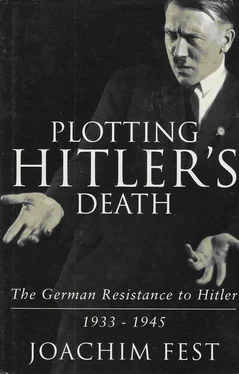


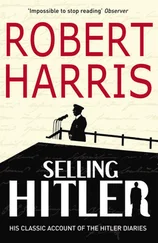
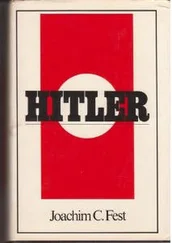
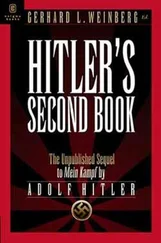
![Traudl Junge - Hitler's Last Secretary - A Firsthand Account of Life with Hitler [aka Until the Final Hour]](/books/416681/traudl-junge-hitler-s-last-secretary-a-firsthand-thumb.webp)





